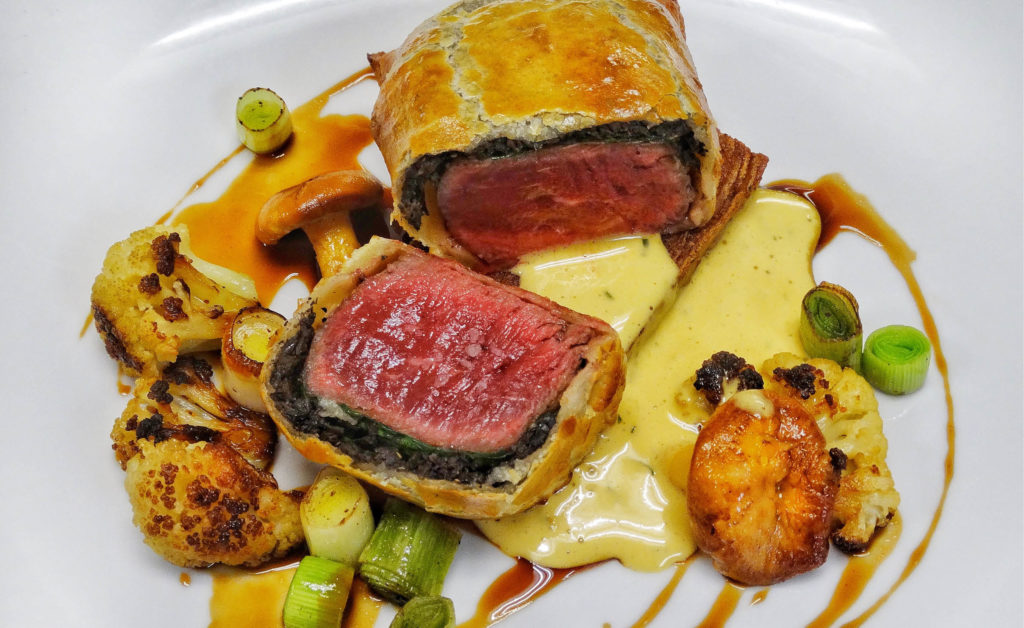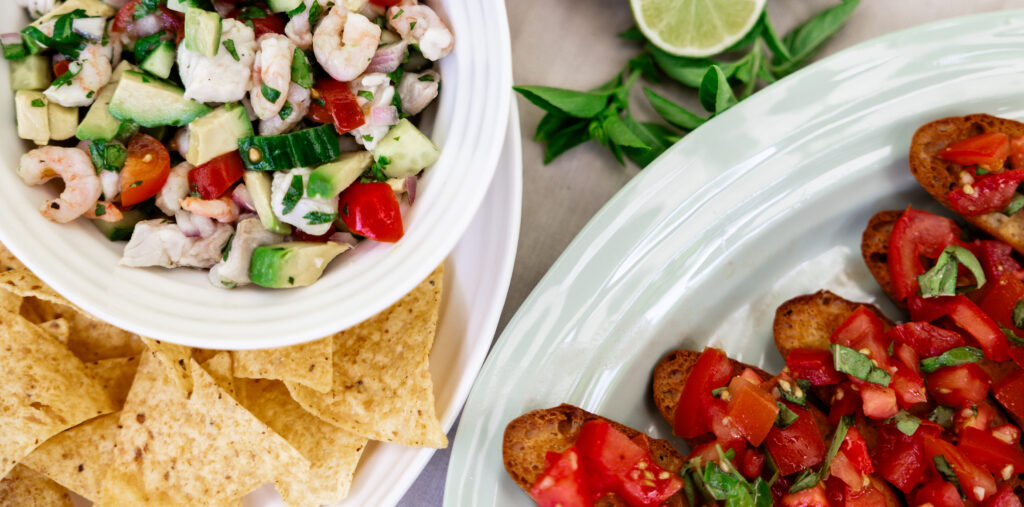by Marcelo Najarr- Executive Chef, 10 Acres Restaurant Group | photo by Kevin Najarro –
We know how our readers love trying the recipes we share each month; now we’re throwing down the gauntlet with a Reader Cookoff! We asked 10 Acres chef Marcelo Najarro to provide a recipe that would challenge the home chef, test their skills and maybe push them outside their culinary comfort zone. We want you to try it out and then share a picture with us – a whole community of cooks making the same dish!
From Chef Marcelo: Why Boeuf En Croute? Well, I think it’s perhaps one of the most indulgent meals one can have. And there is no better time for indulgence than during the holidays! It’s rich, delicious, buttery and flaky when done correctly. Every single element is important, from the golden pastry to the creamy Bearnaise. I don’t make it very often at home, but it’s definitely one of my wife’s favourites, and always good to make when I need a get out jail free card! It’s a challenging dish, but one that is well worth the effort. I’m sure you’ll agree! Good luck and happy cooking. (Serves 2)
Beef
14oz beef tenderloin
3 tbsp canola oil
salt
black pepper
120g fresh spinach
1 egg
Mushroom Duxelles
1.5 tbsp butter
85g shallots, finely chopped
2 tbsp fresh thyme leaves
8 oz button/cremini mushrooms,
finely chopped
2 tbsp minced garlic
4 tbsp white white
½ cup heavy cream
juice of ½ a fresh lemon
salt + pepper
Short Crust
250g all purpose flour
150g COLD butter
1 egg
2 tbsp COLD water or
COLD white wine
1 tsp salt
Bearnaise
4 large egg yolks
1 cup butter
2 bay leafs (optional)
4 tbsp dry white wine
4 tbsp white wine vinegar
1 tbsp water
1 tbsp fresh lemon juice
2 shallots bulbs, chopped
several stems fresh tarragon
salt
Step 1
Begin with making your shortcrust dough. This can be made a day or two prior! The key is when adding the wet ingredients to not overwork the dough; mix just enough so it stays together.
In a mixing bowl add your flour and salt. Cut your cold butter into rough 1″ chunks, then place in bowl with dry ingredients. Using a pastry cutter or two butter knives, cut your butter into smaller chunks in the bowl. Allow the flour to coat the butter pieces. Repeat, cutting the butter into small lumps while tossing throughout the flour. You want to create a grainy texture, with butter now roughly the size of peas.
Make a well in the centre of the bowl and add your egg. Lightly mix with a spoon; dough will still be crumbly. Then add water or wine a few drops at a time, and mix lightly, folding from the bottom to the top. A dough should form with slight tackiness and have some loose crumbs. Using your hands, gather dough together from the bowl. Form a thick rectangle and wrap with plastic wrap. Allow to chill in the fridge for 30 minutes or more.
Step 2 | Mushroom Duxelles
Melt butter in frying pan on medium heat. Add shallots and a sprinkle of salt and black pepper. Occasionally stir; allow shallots to cook in butter slowly, becoming softer and translucent. Next add the garlic; stir throughout the shallots. Cook for a few minutes until garlic is also softened and has lots of colour.
Add the mushrooms and thyme. Cook on medium high heat while mushrooms shrink in volume and release their liquid. Continue stirring until the moisture is gone and you have an almost-dry frying pan. Add wine and cream. Cook on medium high heat, to cook away the liquid, stir often.
The mixture should resemble a thick, coarse paste when ready, with most of the liquids evaporated. Squeeze in the juice of half a lemon, then remove from the heat. Taste and add more salt and pepper if needed. Cool.
Step 3
Pre heat your oven to 350°F Remove your refrigerated tenderloin piece. Thoroughly sprinkle with salt and pepper. On high, heat a heavy skillet pan with enough canola oil to lightly coat the entire bottom of your pan.
Gently place your meat into the hot pan. Cook for 1-3 minutes on each side, creating a dark brown crust on the tenderloin. Rotate the meat until each side has been seared, sealing in the raw moist meat. Remove from heat and place on a paper towel to absorb extra moisture.
Step 4
Take your refrigerated shortcrust. On a lightly floured surface, roll out into a rectangle ⅛ inch thick that will cover all of your tenderloin when rolled up cylindrically, with some excess dough. Roughly 10″ x 10″.
Lay a thin layer of fresh spinach down on the dough, slightly smaller than the rectangle itself, to leave 1″ border. Next, gently spread your mushroom duxelle top of of the spinach, creating an even layer while still leaving a border of dough showing.
Brush the exposed border of dough with a whisked egg. This will create glue for the dough. Lay the tenderloin down at one end of the rectangle. From this end, gently roll the dough, holding it against your tenderloin until the tenderloin is rolled over, and completely covered by the dough. Gently press the two edges of the rectangle that have met together. Do the same with the two open ends, pinching the dough together to completely seal in the tenderloin with no spinach or mushroom duxelle showing.
Brush the exterior of your wellington with egg wash (an egg whisked with a tablespoon of water). Place on a piece of baking parchment in the centre of oven. Bake for 30-40 minutes until crust is golden. We recommend checking the internal temperature of your meat with a thermometer as you want to ensure it is warm inside for the recommended med rare doneness look for 120°F .
Remove from oven, and allow to stand for 5-8 minutes before cutting and serving. This allows internal temperature to settle.
Step 5 | Bearnaise Sauce
In a small pot, combine bay leaves, white wine, vinegar, water, chopped shallots and tarragon. Bring to a simmer gently over medium heat, reducing to about ½ in volume. This is the bearnaise reduction.
Strain, then add the fresh lemon juice and allow to cool to room temperature.
Next gently melt your butter, to a pourable consistency. Fill a pot with water ¾ of the way. Bring to a simmer. In a heat-proof bowl place 2 tablespoons bearnaise reduction and the egg yolks. Sit the bowl on top of the simmering pot of water; this should entirely cover the water and steam below. We recommend using an oven mitt to hold your bowl steady, as it will get warm.
Immediately begin whisking. Add a few drops at a time of the melted butter. Continue whisking, ensure as you mix you have your whisk against the bottom of the bowl, naturally scraping it. Each time the butter is no longer visible in the egg yolks, add another few drops. Repeat until all the butter is completely incorporated and add salt to taste. This should create a thick sauce comparable to loose mayonnaise.
During this process you do not want the eggs to start to cooking so much they resemble scrambled eggs or start to steam. Lower your pot’s simmering temperature if this starts to happen.
Send a picture of your Boeuf en Croute to news@seasidemagazine.ca OR tag us @seasidemagazine on Facebook or Instagram. At the end of January, we’ll draw a name from the entrants for a foodie prize!




